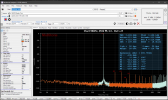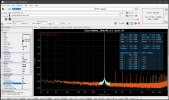Since the OP is struggling to complete his existing set of tests, thought this might help in the meanwhile. First, let‘s consider conditions. I am using a preproduction of the same amp and measuring it with my E1DA/E50 combo. From previous experience, I already know noise is more difficult to tame in my test rig, so will measure only the distortion component. Perhaps the OP can reproduce my approach with his AP if he has the time.
Next, some other considerations. First, am going to use a baseline distortion measurement at 1k Hz with a 4 ohm non-inductive dummy load. Second, since you requested a higher frequency, going to use 5k Hz with the same load. Third, since the amp’s output filter attenuates significantly after 20kHz, will focus on THD that is second and third harmonic to help ensure the 2 measurements are being equitably compared.
Here is the comparison…
View attachment 309826
You can see that for most of output of the amp, THD is very comparable with a slight divergence around 240 watts where there is slightly higher distortion for the higher frequency than the lower one. So, whereas in SINAD where noise is included in the metric, there is a more significant divergence at lower power. As is in a more established test environment, see @amirm’s testing of the NCx500 monoblock for reference…
View attachment 309837
So, along with other testing experience, my conclusion is that when you see greater divergence at higher frequencies, it is likely due to higher noise rather rising distortion. I will further condition this based on the test environment being well controlled and baselined. We have all seen what can happen to these very low measurements when contacts are too loose. Am being very careful to ensure solid contact and consistent conditions are being applied with each measurement. If this is not done, then the test rig can skew the measurements and the results cannot be accurately compared.
Hope this helps!



